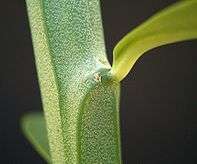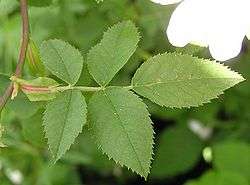Stipule
In botany, stipule (Latin stipula: straw, stalk) is a term coined by Linnaeus[1] which refers to outgrowths borne on either side (sometimes just one side) of the base of a leafstalk (the petiole). A pair of stipules is considered part of the anatomy of the leaf of a typical flowering plant, although in many species the stipules are inconspicuous or entirely absent (and the leaf is then termed exstipulate).
In some older botanical writing, the term "stipule" was used more generally to refer to any small leaves or leaf-parts, notably prophylls.[2]
Stipules are morphologically variable and might appear as glands, scales, hairs, spines, or laminar (leaf-like) structures. A relationship exists between the anatomy of the stem node and the presence or absence of stipules: most plants with trilacunar nodes have stipules; species with unilacunar nodes lack stipules.[3]
Types of stipules
 Glandular stipule of Euphorbia pteroneura |
 |
 |
 |
 Stipules building glandular hairs on Jatropha spicata |
 |
 Stipular spine clusters of Euphorbia spectabilis |
 |
References
- ↑ Concise English Dictionary Wordsworth Editions Ltd. 1994, ISBN 1-85326-328-1
- ↑ Goebel, K.E.v. (1969) [1905]. Organography of plants, especially of the Archegoniatae and Spermaphyta. Part 2 Special organography. translated by I.B. Balfour. New York: Hofner publishing company.
- ↑ Sinnott, E. W. and I. W. Bailey (1914). "Investigations on the phylogeny of the angiosperms. 3. Nodal anatomy and the morphology of stipules". American Journal of Botany 1: 441–453. doi:10.2307/2435043.
General references
- Esau, K. 1953. Plant Anatomy. Second Edition. John Wiley & Sons, Inc., New York, London, Sidney. 767 pp.